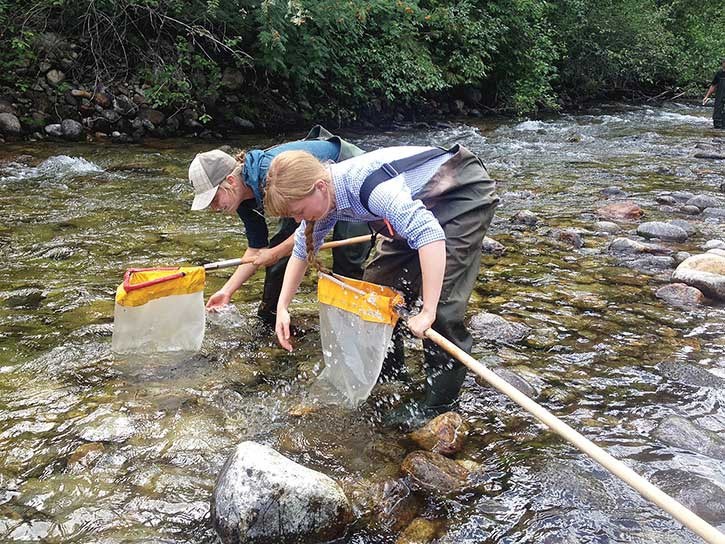 If you’ve noticed folks sporting waders and meter sticks, shimmying down the bonny banks of Windermere Creek, you’ve likely caught a glimpse of CABIN at work.
If you’ve noticed folks sporting waders and meter sticks, shimmying down the bonny banks of Windermere Creek, you’ve likely caught a glimpse of CABIN at work.
Since 2009, your local Lake Ambassadors have been working with Living Lakes Canada and Wildsight to collect data on Windermere Creek, as part of the Columbia Basin Water Quality Monitoring Project.
We are proud to report that this summer, the program co-ordinator and watershed stewardship assistant of Lake Windermere Ambassadors received accreditation as Field Technicians for CABIN monitoring protocol (see action shot below!).
CABIN (Canadian Aquatic Biomonitoring Network) is an aquatic biomonitoring program maintained by Environment Canada that is used to assess the health of freshwater ecosystems in Canada. The program includes assessments for stream characteristics like substrate, slope, channel and flow velocity. It also includes water chemistry and testing for benthic macroinvertebrate communities.
Benthic (meaning “bottom-living”) macro- (retained by mesh net sizes 200-500 μm) invertebrates (no backbone) are essentially aquatic insects and larvae that live at the bottom of the stream for at least a portion of their life cycle. They are considered excellent indicators of long-term stream health because they are:
• sedentary (stay in one place)
• generally abundant (can be found across Canada)
• live one to three years (reflecting impacts to a creek over time)
• diverse (respond to a wide range of stressors)
• a key part of the food web (ecologically important)
 Windermere Creek was initially chosen as a test site for this project because it is the largest tributary to Lake Windermere other than the Columbia River. It is also habitat to four native fish species and important spawning grounds for kokanee salmon. There are several upstream influences on the creek that factor in to watershed health dynamics.
Windermere Creek was initially chosen as a test site for this project because it is the largest tributary to Lake Windermere other than the Columbia River. It is also habitat to four native fish species and important spawning grounds for kokanee salmon. There are several upstream influences on the creek that factor in to watershed health dynamics.
For example, water licences (more than 45), logging, mining, golf courses, agriculture and residential development also have potential to impact water quality and quantity downstream.
In recent years, benthic communities have been nearly wiped out in Windermere Creek. Transfer of fine sediment from large erosion events increases turbidity and leaves minimal space at the bottom of the creek for aquatic insects to live (also directly compromising spawning habitat for important fish species like kokanee salmon). Encouragingly, data collected since 2009 show that once the creek stabilizes, aquatic insects have been able to re-establish fairly successfully.
To learn more about CABIN or to check out their public database, go to ec.gc.ca/rcba-cabin.
We’d like to acknowledge the Columbia Basin Watershed Network for providing funding support for our team to attend the CABIN certification course delivered expertly by Living Lakes, and Columbia Basin Water Quality Monitoring Project Team for their phenomenal partnership.

Fun fact! Did you know that caddisfly larvae (Trichoptera) build cases to protect themselves out of material from their surroundings (vegetation, sand, pebbles, shells) bound together with silk?
Beneath The Surface is based on the principle that there is often more to know than what is visible from the “surface” of an issue. If there is something that concerns you about the lake and you want to get to the “bottom of it,” call Lake Windermere Ambassadors program co-ordinator Megan Peloso at 250-341-6898 or email info@lakeambassadors.ca and inspire the next column!
